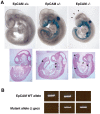Abnormal placental development and early embryonic lethality in EpCAM-null mice
- PMID: 20046825
- PMCID: PMC2796178
- DOI: 10.1371/journal.pone.0008543
Abnormal placental development and early embryonic lethality in EpCAM-null mice
Abstract
Background: EpCAM (CD326) is encoded by the tacstd1 gene and expressed by a variety of normal and malignant epithelial cells and some leukocytes. Results of previous in vitro experiments suggested that EpCAM is an intercellular adhesion molecule. EpCAM has been extensively studied as a potential tumor marker and immunotherapy target, and more recent studies suggest that EpCAM expression may be characteristic of cancer stem cells.
Methodology/principal findings: To gain insights into EpCAM function in vivo, we generated EpCAM -/- mice utilizing an embryonic stem cell line with a tacstd1 allele that had been disrupted. Gene trapping resulted in a protein comprised of the N-terminus of EpCAM encoded by 2 exons of the tacstd1 gene fused in frame to betageo. EpCAM +/- mice were viable and fertile and exhibited no obvious abnormalities. Examination of EpCAM +/- embryos revealed that betageo was expressed in several epithelial structures including developing ears (otocysts), eyes, branchial arches, gut, apical ectodermal ridges, lungs, pancreas, hair follicles and others. All EpCAM -/- mice died in utero by E12.5, and were small, developmentally delayed, and displayed prominent placental abnormalities. In developing placentas, EpCAM was expressed throughout the labyrinthine layer and by spongiotrophoblasts as well. Placentas of EpCAM -/- embryos were compact, with thin labyrinthine layers lacking prominent vascularity. Parietal trophoblast giant cells were also dramatically reduced in EpCAM -/- placentas.
Conclusion: EpCAM was required for differentiation or survival of parietal trophoblast giant cells, normal development of the placental labyrinth and establishment of a competent maternal-fetal circulation. The findings in EpCAM-reporter mice suggest involvement of this molecule in development of vital organs including the gut, kidneys, pancreas, lungs, eyes, and limbs.
Conflict of interest statement
Figures






Similar articles
-
EpCAM and the biology of hepatic stem/progenitor cells.Am J Physiol Gastrointest Liver Physiol. 2015 Feb 15;308(4):G233-50. doi: 10.1152/ajpgi.00069.2014. Epub 2014 Dec 4. Am J Physiol Gastrointest Liver Physiol. 2015. PMID: 25477371 Free PMC article. Review.
-
Abnormal labyrinthine zone in the Hectd1-null placenta.Placenta. 2016 Feb;38:16-23. doi: 10.1016/j.placenta.2015.12.002. Epub 2015 Dec 13. Placenta. 2016. PMID: 26907377 Free PMC article.
-
Keratin 5-Cre-driven excision of nonmuscle myosin IIA in early embryo trophectoderm leads to placenta defects and embryonic lethality.Dev Biol. 2013 Oct 1;382(1):136-48. doi: 10.1016/j.ydbio.2013.07.017. Epub 2013 Jul 30. Dev Biol. 2013. PMID: 23911870 Free PMC article.
-
Sirtuin1 is required for proper trophoblast differentiation and placental development in mice.Placenta. 2018 Feb;62:1-8. doi: 10.1016/j.placenta.2017.12.002. Epub 2017 Dec 7. Placenta. 2018. PMID: 29405961 Free PMC article.
-
Epithelial cell adhesion molecule expression (CD326) in cancer: a short review.Cancer Treat Rev. 2012 Feb;38(1):68-75. doi: 10.1016/j.ctrv.2011.04.002. Epub 2011 May 14. Cancer Treat Rev. 2012. PMID: 21576002 Review.
Cited by
-
Cancer-associated epithelial cell adhesion molecule (EpCAM; CD326) enables epidermal Langerhans cell motility and migration in vivo.Proc Natl Acad Sci U S A. 2012 Apr 10;109(15):E889-97. doi: 10.1073/pnas.1117674109. Epub 2012 Mar 12. Proc Natl Acad Sci U S A. 2012. PMID: 22411813 Free PMC article.
-
Cleavage and cell adhesion properties of human epithelial cell adhesion molecule (HEPCAM).J Biol Chem. 2015 Oct 2;290(40):24574-91. doi: 10.1074/jbc.M115.662700. Epub 2015 Aug 19. J Biol Chem. 2015. PMID: 26292218 Free PMC article.
-
EPCAM mutation update: Variants associated with congenital tufting enteropathy and Lynch syndrome.Hum Mutat. 2019 Feb;40(2):142-161. doi: 10.1002/humu.23688. Epub 2018 Nov 29. Hum Mutat. 2019. PMID: 30461124 Free PMC article.
-
EpCAM and the biology of hepatic stem/progenitor cells.Am J Physiol Gastrointest Liver Physiol. 2015 Feb 15;308(4):G233-50. doi: 10.1152/ajpgi.00069.2014. Epub 2014 Dec 4. Am J Physiol Gastrointest Liver Physiol. 2015. PMID: 25477371 Free PMC article. Review.
-
mTrop1/Epcam knockout mice develop congenital tufting enteropathy through dysregulation of intestinal E-cadherin/β-catenin.PLoS One. 2012;7(11):e49302. doi: 10.1371/journal.pone.0049302. Epub 2012 Nov 28. PLoS One. 2012. PMID: 23209569 Free PMC article.
References
-
- Edwards DP, Grzyb KT, Dressler LG, Mansel RE, Zava DT, et al. Monoclonal antibody identification and characterization of a Mr 43,000 membrane glycoprotein associated with human breast cancer. Cancer Res. 1986;46:1306–1317. - PubMed
-
- Ross AH, Herlyn D, Iliopoulos D, Koprowski H. Isolation and characterization of a carcinoma-associated antigen. Biochem Biophys Res Commun. 1986;135:297–303. - PubMed
-
- Bergsagel PL, Victor-Kobrin C, Timblin CR, Trepel J, Kuehl WM. A murine cDNA encodes a pan-epithelial glycoprotein that is also expressed on plasma cells. J Immunol. 1992;148:590–596. - PubMed
-
- Borkowski TA, Nelson AJ, Farr AG, Udey MC. Expression of gp40, the murine homologue of human epithelial cell adhesion molecule (Ep-CAM), by murine dendritic cells. Eur J Immunol. 1996;26:110–114. - PubMed
Publication types
MeSH terms
Substances
Grants and funding
LinkOut - more resources
Full Text Sources
Molecular Biology Databases
Miscellaneous

